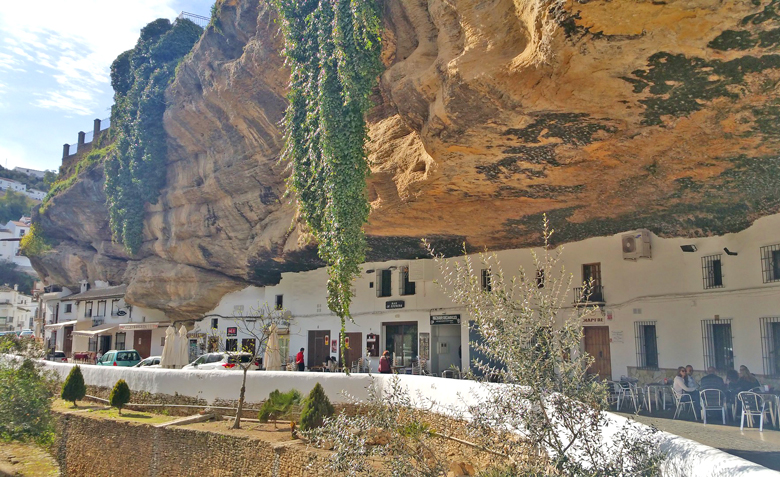Setenil de las Bodegas is a small a picturesque village between Ronda and Olvera in the province of Cadiz in Andalusia (southern Spain), located on the Ruta de los Pueblos Blancos (White Towns Road).
The name of the village is of Latin origin and means seven times nothing (lat. Septem nihil). This stems from the time of the conquest of Moorish Spain by the Catholic Kings. The area around Setenil was a border area between the Moors and the Christians for about 200 years, and only after the seventh attempt did the village fall into Christian hands in 1485.
Today Setenil attracts tourists with whole streets of houses, whose walls and roof are a basalt rock, on the slope of which the village is located.Especially in the town center you will find a large number of houses, built into the steep cliffs that were once hollowed out by the River Guadalporcun. The overhanging rocks often serve as house roofs, making the village semi-subterranean.
The main attraction of this municipality is the same town, declared a Historic-Artistic Site in 1985, due to the beauty and originality of its urban fabric.
Access : Coordinates: 36.8625, -5.181389 / Located 96 km from Malaga, 116 km from Seville and 135 km from Cadiz, the best way to get to Setenil de las Bodegas is by car since it does not have a railway line and the nearest bus station is Alcala del Valle located 4.67 kilometers where there are bus connections to Malaga and other provincial capitals.
Highlights :
- Houses in Setenil : The main attraction of the town is its cave houses, built centuries ago sheltered from the rocks, taking advantage of the pit created by the river as it passes through the town , what you can not miss without any doubts It is the monumental beauty and originality of the “shelter under rocks”, which is how this type of construction is known, where the house is not built by drilling the mountain.
This is an exceptional example of a type of housing called “shelter under rocks” that, unlike other semi-pylodytic constructions developed in Andalusia, does not excavate the rock, but limits itself to closing the rock wall and develops the house longitudinally . - Castillo de Setenil de las Bodegas – Nazari Castle : the Castle of Setenil, (13th century) a castle with about 530m of wall and 40 towers, with an almost intact medieval framework.Under the protection of the generic Declaration of the Decree of April 22, 1949, and Law 16/1985 on Spanish Historical Heritage. Visits : It is freely accessible.
- Cuevas del Sol Street : Cuevas del Sol Street is undoubtedly the best known way to see in Setenil de las Bodegas,It is a narrow street normally crowded with tourists, on the side of which is the small river Trejo. The main feature of this street, as its name suggests, is that its houses are excavated in the mountain and receive sunlight for most of the day.The first is undoubtedly the best known and is possibly the best known image and therefore, the most photographed street.
- Cuevas de la Sombra Street : In this street you will also find cave houses where, due to the narrowness of the street, sunlight hardly reaches. Here you will find food establishments and various very sweet artisan patisseries.
- Plaza de Andalucia : one of the most beautiful to see in Setenil de las Bodegas. In this street you will find several bank branches, bars and coffee shops.
- Calle Calcetas Street : One of the most beautiful streets to see in Setenil de las Bodegas is Calle Calcetas, where you will find beautiful cave houses. To get there you must cross the arch from the Plaza de Andalucia through Callejon Street, just in the curve, next to the Hotel Villa de Setenil, you will find some stairs that will lead you to Calcetas Street.
- the Hermitage of San Sebastian : 15th-16th century ,located on the outskirts and next to the viewpoint, which will offer us spectacular views of the historic center.
- Damita de Setenil House : This is an interesting museum that takes a tour of the history of the town through archaeological elements found during the excavations carried out in the town in 1997.
- El Lizon viewpoint : from where you can see breathtaking views of the town and its urban center / Hermitage of Our Lady of the Conception. 18th century / San Roman caves. 16th century / Triana Street Bridge. From the XV-XVI centuries
- Church of Our Lady of the Incarnation. Mudejar and Gothic styles. (XV century-XVII century). One of the biggest features is that it really consists of two churches, one Mudejar and one Gothic.
- Hermitage of San Benito. From the XV-XVI centuries. Built on a mosque in the Moorish suburb, near a fountain. In 1502 he had several lawsuits with residents of the town who wanted to keep the farms that corresponded to him in the distribution of the Catholic Monarchs.
- Villa Bridges. 15th-17th century / Round Street Bridge. 18th century / Streets and historic neighborhoods of the Nazari Fortress / Street of the Prince of the King / Llana street – Torreon neighborhood. Homes surrounding the Tower of Homage, in what was the Plaza de Armas. / Adarve neighborhood – Espolon Tower neighborhood – Mina neighborhood.
Activities : sightseeing / photo opportunities / trekking / walking between the narrow streets / enjoy popular architecture
Events : Holy Week stands out, declared of National Tourist Interest of Andalusia / Puerto del Monte , which is held in May / The patrons of the town are San Sebastian, on January 20
Go next : Torre Alhaquime / Olvera / Zahara de la Sierra / Ronda / Montejaque / Benaojan / Zahara la Sierra / Grazalema

